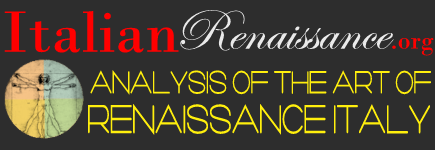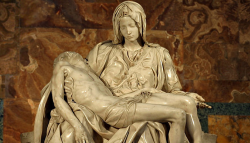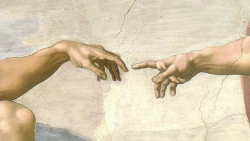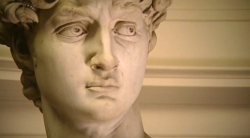Having finished his labours for that lord, he complied with the request of a Prior of Florence who was then at S. Cataldo d’Arimini, and made a S. Thomas Aquinas, reading to his friars, without the door of the church. Departing thence, he returned to Ravenna and painted a chapel in fresco in S. Giovanni Evangelista, which is much extolled. Having next returned to Florence with very great honour and ample means, he painted a Crucifix on wood and in distemper for S. Marco, larger than life and on a ground of gold, which was placed on the right hand in the church. And he made another like it in S. Maria Novella, whereon Puccio Capanna, his pupil, worked in company with him; and this is still to-day over the principal door, on the right as you enter the church, over the tomb of the Gaddi. And in the same church, over the tramezzo,[11] he made a S. Louis for Paolo di Lotto Ardinghelli, and at the foot thereof the portrait of him and of his wife, from the life.
Afterwards, in the year 1327, Guido Tarlati da Pietramala, Bishop and Lord of Arezzo, died at Massa di Maremma in returning from Lucca, where he had been to visit the Emperor, and after his body had been brought to Arezzo and the most magnificent funeral honours had been paid to it, Piero Saccone and Dolfo da Pietramala, the brother of the Bishop, determined that there should be made for him a tomb in marble worthy of the greatness of so notable a man, who had been a lord both spiritual and temporal, and head of the Ghibelline party in Tuscany. Wherefore, having written to Giotto that he should make the design of a tomb very rich and with all possible adornment, and having[Pg 86] sent him the measurements, they prayed him afterwards that he should place at their disposal the sculptor who was the most excellent, according to his opinion, of all that were in Italy, because they were relying wholly on his judgment. Giotto, who was most courteous, made the design and sent it to them; and after this design, as will be told in the proper place, the said tomb was made. And because the said Piero Saccone had infinite love for the talent of this man, having taken Borgo a San Sepolcro no long time after he had received the said design, he brought from there to Arezzo a panel with little figures by the hand of Giotto, which afterwards fell to pieces; and Baccio Gondi, nobleman of Florence, a lover of these noble arts and of every talent, being Commissary of Arezzo, sought out the pieces of this panel with great diligence, and having found some brought them to Florence, where he holds them in great veneration, together with some other works that he has by the hand of the same Giotto, who wrought so many that their number is almost beyond belief. And not many years ago, chancing to be at the Hermitage of Camaldoli, where I have wrought many works for those reverend Fathers, I saw in a cell, whither it had been brought by the Very Reverend Don Antonio da Pisa, then General of the Congregation of Camaldoli, a very beautiful little Crucifix on a ground of gold, with the name of Giotto in his own hand; which Crucifix, according to what I hear from the Reverend Don Silvano Razzi, monk of Camaldoli, is kept to-day in the cell of the Superior of the Monastery of the Angeli, as being a very rare work and by the hand of Giotto, in company with a most beautiful little picture by Raffaello da Urbino.
For the Frati Umiliati of Ognissanti in Florence, Giotto painted a chapel and four panels, in one of which there was the Madonna, with many angels round her and the Child in her arms, and a large Crucifix on wood, whereof Puccio Capanna took the design and wrought many of them afterwards throughout all Italy, having much practice in the manner of Giotto. In the tramezzo[12] of the said church, when this book of the Lives of the Painters, Sculptors, and Architects was printed the first time, there was a little panel in distemper painted by Giotto with infinite[Pg 87] diligence, wherein was the death of Our Lady, with the Apostles round her and with a Christ who is receiving her soul into His arms. This work was much praised by the craftsmen of painting, and in particular by Michelagnolo Buonarroti, who declared, as was said another time, that the quality of this painted story could not be more like to the truth than it is. This little panel, I say, having come into notice from the time when the book of these Lives was first published, was afterwards carried off by someone unknown, who, perhaps out of love for art and out of piety, it seeming to him that it was little esteemed, became, as said our poet, impious. And truly it was a miracle in those times that Giotto had so great loveliness in his painting, considering, above all, that he learnt the art in a certain measure without a master.
After these works, in the year 1334, on July 9, he put his hand to the Campanile of S. Maria del Fiore, whereof the foundation was a platform of strong stone, in a pit sunk twenty braccia deep from which water and gravel had been removed; upon this platform he made a good mass of concrete, that reached to the height of twelve braccia above the first foundation, and the rest—namely, the other eight braccia—he caused to be made of masonry. And at this beginning and foundation there officiated the Bishop of the city, who, in the presence of all the clergy and all the magistrates, solemnly laid the first stone. This work, then, being carried on with the said model, which was in the German manner that was in use in those times, Giotto designed all the scenes that were going into the ornamentation, and marked out the model with white, black, and red colours in all those places wherein the marbles and the friezes were to go, with much diligence. The circuit round the base was one hundred braccia—that is, twenty-five braccia for each side—and the height, one hundred and forty-four braccia. And if that is true, and I hold it as of the truest, which Lorenzo di Cione Ghiberti has left in writing, Giotto made not only the model of this campanile, but also part of those scenes in marble wherein are the beginnings of all the arts, in sculpture and in relief. And the said Lorenzo declares that he saw models in relief by the hand of Giotto, and in particular those of these works; which circumstance can be easily believed, design and[Pg 88] invention being father and mother of all these arts and not of one alone. This campanile was destined, according to the model of Giotto, to have a spire, or rather a pyramid, four-sided and fifty braccia high, as a completion to what is now seen; but, for the reason that it was a German idea and in an old manner, modern architects have never done aught but advise that it should not be made, the work seeming to be better as it is. For all these works Giotto was not only made citizen of Florence, but was given a pension of one hundred florins yearly by the Commune of Florence, which was something very great in those times; and he was made overseer over this work, which was carried on after him by Taddeo Gaddi, for he did not live so long as to be able to see it finished.



